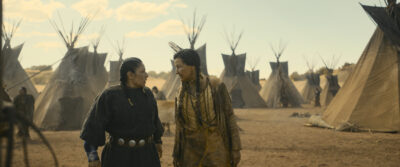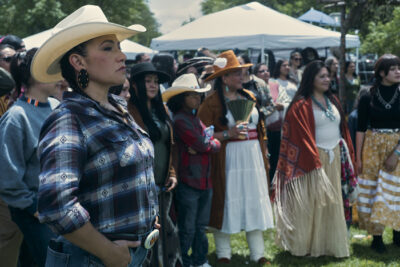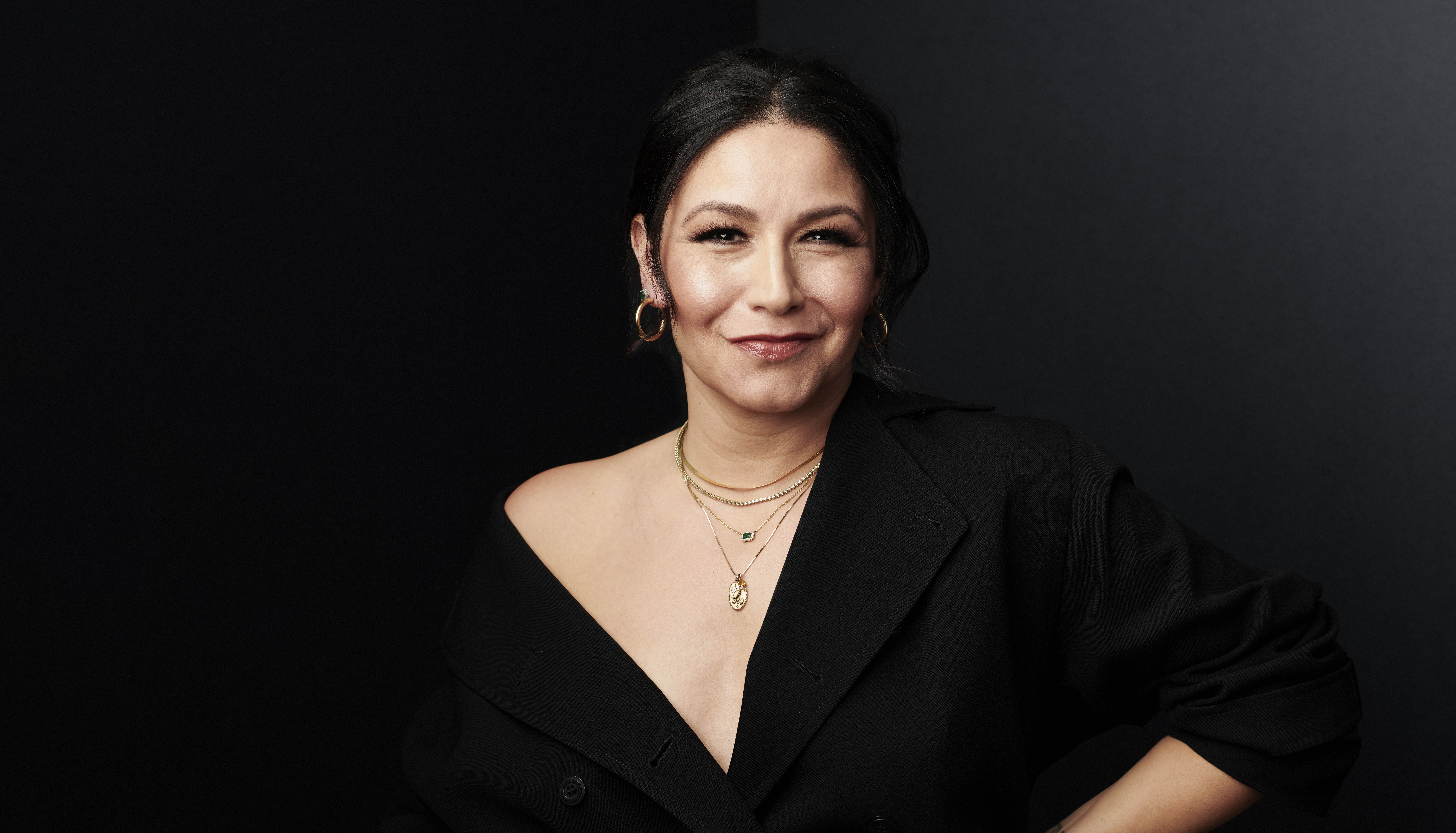In the genre-bending, time-travelling, neo-Western sci-fi series Outer Range, Tamara Podemski plays a gay, Native sheriff in a predominantly white, and racist, town. While the series is focused on a Wyoming rancher (Josh Brolin) who discovers a gaping void with mysterious capabilities, one episode in the latest season was dedicated to exploring the depths of Tamara’s character, Deputy Sheriff Joy.
In episode 4 of Outer Range Season 2, Sheriff Joy is lost in time with no way to return home, and must navigate a new life among her Shoshone ancestors in 1886. Randy Redroad, co-writer of the episode, was eager to give more context to Joy’s story.
“There’s a lot underneath that’s making her tick, that would make this Shoshone woman who’s married and has a young child do a very dangerous job policing these corrupt and aggressive cowboys. And digging deeply into her character to figure out what made some of that tick was really human and really important,” shares Redroad.
During our conversation, Tamara shares that she was “overwhelmed and overjoyed” at the response to Season 2, and she was thrilled to have the opportunity to dig deeper into Joy’s world.
Following the release of the new season, we had an invigorating conversation with Tamara about the complexities of her character, how Indigenous representation has evolved throughout her 30+ year career, and what being an artist means to her.
Many viewers resonate with your character, Deputy Sheriff Joy. Why do you think she is connecting with people?
Joy had the privilege to have an episode dedicated just to her character’s storyline. It is a very special thing. Her world is so complicated, because she is a small part of a larger world of the town of Wabang. It’s a predominantly white town. It’s a predominantly racist town. She is a gay, Native woman sheriff who chooses to live with her family off the reservation in the middle of this community.
So you’re feeling, all through Season 1, the challenges of that, the hardship, the restriction of that, the silencing of who she is in that community. When you give a character like that the space to be themselves amongst their own people, there’s a real celebration. I think she won people over in Season 1, as a force of good… it was a lot of work to bring people along and invite them into her world. As an actor, it was all my dreams come true.

Courtesy of Prime Video
It was definitely a pivotal episode for Joy. What were your first impressions when you read the script, and how did you prepare to film that episode?
I believe I cried. It was an incredible honour and a very intense responsibility. I’m surrounded by many Indigenous creatives in that episode, so I knew that it wasn’t just on me. But the responsibility of representation, of authenticity, of honouring that place historically—that was ever present through all of it. In Hollywood, it doesn’t happen a lot to have that level of Indigenous representation on screen. So the stakes felt high. There’s a lot of trust, and you rely on years and years of representing your people on camera and knowing how to protect that.
To me, it was a once in life. I’ve never been given an opportunity that big. So I was going to do everything I could to show up for this. A lot of language rehearsals (we were speaking Shoshone), horseback riding, fights and the stunts—it was three weeks straight all leading up to my episode.
When it comes to Indigenous representation on screen, what have been the biggest shifts you’ve witnessed throughout your career?
I was very lucky that I came around at a time in the 90s in Canada, when we had North of 60, The Rez, Dance Me Outside—we had Indigenous representation on TV with real Indigenous actors.
It was taught to me at a very young age that most of the roles I was doing were Native roles. With that came the responsibility that every role had to be looked at to make sure that you’re catching the stereotypes, the prejudices. That’s why we need to be playing those roles…we know what’s wrong, and we know what’s inaccurate, and we can flag that. I still have to do the same work today as I did 30 years ago, of combing through every script and flagging things.
In Canada, it was a very small community that I worked within. With this big American show, I’ve never had an audience or reach like this. So in that way, you can feel the impact of the hard work and making sure you’re representing things authentically. You see how that shifts people’s consciousness and understanding.
View this post on Instagram
You mentioned the high stakes of your standalone episode this season. Has there been a similar challenge in your career that’s pushed you out of your comfort zone?
Transitioning to bigger mainstream stuff was scary. Because yes, it’s bigger stakes and more people will see the work. But it’s also believing that you can play in that field, that you can be toe-to-toe with Josh Brolin! We have a really tight-knit, small, humble community in Canada, and even that one was hard enough for me to break into as a young Native actor. You just get used to being on the periphery. I built a career on being a supporting character. I’m quite comfortable working in that space. Moving to more lead roles, that was the mental and emotional permission of “you belong here.”
What is something about the industry you wish you knew earlier on, while you were building your career in supporting roles?
That bigger isn’t better. I feel lucky that the biggest growth and celebration of my work has happened later on. It is really easy to believe when you start in the industry that it’s only one direction, you’re only going up. That’s just not how the business works. I would have loved to understand that trajectory is bullshit. Momentum is bullshit. There isn’t an equation for how to be successful in this industry. Those stories that we hear of someone doing their first gig and it’s just uphill from there—they make up like 1% of us gigging actors. So that would have been useful to know.

Courtesy of Prime Video
Along with film and TV, you’ve also been involved in dance, theatre and music. What does being an artist mean to you?
I knew early on I was never the best dancer. I was never the best actor. I was never the best singer. But all of them did flow out of me naturally. And I knew that when I did them, I could make people smile, or laugh, or cry. That is our role as artists—to crack open people’s hearts, their minds, their eyes, to allow them to experience this very challenging human experience. And if I can help anyone process the emotional roller coaster of being a human…that’s certainly one of the things I was brought here to do, help people feel things.
You’re also filming the highly-anticipated Apple+ series Murderbot right now! What can you tell us about the show?
Murderbot is pure fun. I am having the time of my life. It’s a dramatic comedy, it’s also another ensemble piece which I love. We are having so much fun, especially bringing the books to life. I do feel like I can reassure the superfans of The Murderbot Diaries. I think they will be very pleased. Our author, Martha Wells, she came to set last week and she was blown away by seeing us, these characters that she imagined a couple of decades ago. It’s my first time in the sci-fi, outer space genre. I’m having the time of my life.
There are high hopes for a third season of Outer Range. If you have the opportunity to continue playing Joy, what is something you’d like to explore about her character?
With this newfound warrior within, I wonder if she can continue in law enforcement. That’s my biggest question when we leave her in the end of Season 2. Her inner warrior, her vigilante… I don’t know. I’m curious, but that’s what I love about Joy, her desire for good, her desire for growth, her desire to better the world. It’s open to all the ways that you can do that. We’ve seen her changing her ideas of how good can actually be achieved. I hope we get a chance to see!



 Follow Us On Instagram
Follow Us On Instagram
